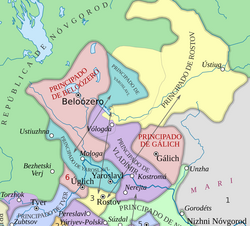Principality of Yaroslavl
You can help expand this article with text translated from the corresponding article in Russian. (June 2021) Click [show] for important translation instructions.
|
Principality of Yaroslavl Ярославское княжество (Russian) | |
|---|---|
| 1218–1463 | |
 Principality of Yaroslavl c. 1350 | |
| Status | Principality |
| Capital | Yaroslavl 57°38′N 39°53′E / 57.633°N 39.883°E |
| Common languages | Russian |
| Religion | Russian Orthodoxy |
| Government | Monarchy |
| History | |
• Established | 1218 |
• Disestablished | 1463 |
| Today part of | Russia |

The Principality of Yaroslavl (
History
Foundation
The Principality of Yaroslavl separated from
In 1238, the city was sacked by the Mongols during the
In 1262, an uprising against the Mongol tribute collectors ended in the killing of all the local Tatars. The punitive attack was prevented by Alexander Nevsky, who went to the Golden Horde for negotiations.[2]
During the Mongol-Tatar Yoke
Later, the sons of Vsevolod Konstantinovich ruled in the principality. Vasilii Vsevolodovich stayed in power from 1238 to 1249. His brother Konstantin Vsevolodovich ruled after his death. On 3 July 1257, the battle of Tugova Gora ended with another defeat of the Russians, and Konstantin Vsevolodovich was killed. Then a group of princes decided Vasilii's son-in-law should be ruler: Fedor Rostislavich Cherni, son of the ruler of Smolensk. His second wife was Anna, a daughter of the warlord Mengu-Timur.
In 1332,
The last grand prince of Yaroslavl was Aleksandr Fedorovich Brukhatii who was forced to sign away the succession to
Notes
- ^ "Yaroslavl". britannica.com.
- ^ Egorov 1996.
- ^ "The dual genealogy of the Rostislavich family who became rulers at Yaroslavl".
- ^ Great Soviet Encyclopedia (1978), vol. 30, p. 559
Sources
- Egorov, V. L. Александр Невский и Золотая Орда [Alexander Nevsky and the Golden Horde] (in Russian). Novgorod: Novgorod State Museum.
